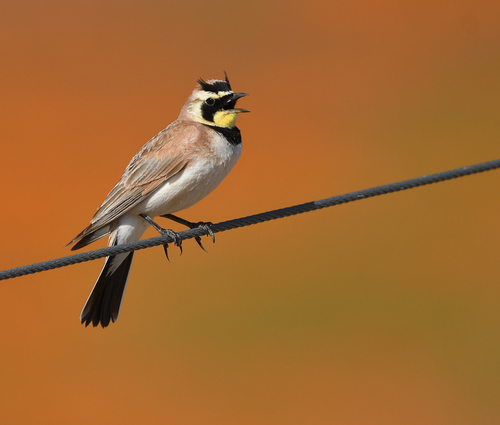
Horned Lark
The Horned Lark (*Eremophila alpestris*) is a widespread songbird known for its distinctive 'horns,' which are actually feather tufts, and its melodious song. It is a bird of open country, found across a vast range of habitats from arctic tundra to high-altitude grasslands and deserts. This adaptability has allowed it to be one of the most successful lark species. Ecologically, the Horned Lark plays a role in seed dispersal and insect control. While not typically considered a bird of major cultural significance, its presence in diverse landscapes makes it a familiar sight to many.
16-20 cm
Length
30-36 cm
Wingspan
Least Concern
Conservation Status
Distribution
The Horned Lark has an extremely wide distribution, found across North America, northern Eurasia, and parts of North Africa. In North America, it breeds from the high Arctic south to southern Mexico. Populations in northern regions are migratory, moving south for the winter. Altitudinal range varies from sea level to over 4,000 meters.
Lifespan
The typical lifespan in the wild is not well documented but is estimated to be 2-5 years. Longer lifespans have been recorded in captivity.
Horned Lark's Habitat
Habitat Types
Tundra, Grasslands, Deserts, Agricultural fields, Alpine meadows, Coastal dunes
Climate Zones
Arctic, Temperate, Subtropical, Arid
Adaptations
Horned Larks are adapted to open habitats with sparse vegetation. Their cryptic coloration provides camouflage on the ground. They have relatively long legs for running and foraging on the ground. Some populations in arid environments may have adaptations for water conservation.
Variations
There are numerous recognized subspecies of Horned Lark (over 40), differing in plumage coloration and size, reflecting adaptations to local environments. For instance, some desert subspecies are paler than those found in more temperate regions.
Appearance
Breeding Plumage
Breeding plumage is generally more vibrant, with males having more distinct black markings on the face and breast. Non-breeding plumage is duller and more streaked.
Seasonal Feather Changes
There is a noticeable shift from the brighter breeding plumage to a duller, more cryptic non-breeding plumage after the breeding season.
Sex Based Plumage Differences
Males have a bolder black 'mask' and breast band, and more prominent 'horns' than females. Females are generally duller and more streaked.
Notable Features
Feather tufts ('horns') on the head (more prominent in males), Black 'mask' and breast band, Yellowish wash on the face and throat, Pale underparts
Diet and Feeding
Primary Foods
Seeds, Insects, Other invertebrates, Small grains
Foraging Behavior
Horned Larks forage primarily on the ground, walking or running while pecking at food items. They may also occasionally take insects in flight.
Specializations
They have strong legs and feet adapted for ground foraging. Their bill is relatively short and stout, suitable for picking up seeds and small invertebrates.
Seasonal Diet Variations
Diet varies seasonally. Insects and other invertebrates are more important during the breeding season, providing protein for growing chicks. Seeds form the bulk of the diet during the winter months.
Behavior
Social Structure
Horned Larks are generally territorial during the breeding season. Outside of the breeding season, they often form flocks, sometimes quite large, especially during migration and winter.
Communication
Complex songs, especially during breeding displays, Variety of calls, including contact calls and alarm calls, Visual displays, such as raising the 'horns'
Migration
Many populations are migratory, with northern breeders moving south for the winter. Migration is often undertaken in flocks, and they may travel long distances.
Territorial or Group Behaviors
During the breeding season, males defend territories through song and visual displays. Outside of breeding, they are more gregarious and form flocks.
Conservation
Threats
Habitat loss (due to agriculture and urbanization), Pesticide use, Climate change (affecting breeding habitat and food availability)
Protection Programs
Some regional conservation efforts focused on grassland habitat restoration, Monitoring programs to track population trends
Local National Laws
Protected under the Migratory Bird Treaty Act in the United States and Canada.
Population Trend
Overall, the population trend is considered stable, although some regional declines have been noted.
Population Estimates
The global population is estimated to be in the tens of millions.
Interesting Facts
They are one of the few North American songbirds that breed in the high Arctic.
This demonstrates their remarkable adaptability to harsh environments.
Their 'horns' are not actually horns, but tufts of feathers.
These feathers can be raised or lowered, and are used in displays.
They are known for their ground-dwelling habits.
Unlike many other songbirds, they rarely perch in trees or shrubs.
The numerous subspecies demonstrate significant variation.
Over 40 subspecies have evolved based on geographic location.
Faqs about Horned Lark
What is the purpose of the Horned Lark's 'horns'?
The 'horns' are feather tufts used in displays, particularly by males during courtship.
Where can I see a Horned Lark?
Look for them in open habitats such as grasslands, fields, and tundra. They are often seen on the ground.
Do Horned Larks migrate?
Many populations are migratory, moving south for the winter. However, some populations are resident year-round.
Are Horned Larks endangered?
No. Horned Larks are listed as 'Least Concern' by the IUCN, meaning they are not currently facing a high risk of extinction.
Copyright @ Nature Style Limited. All Rights Reserved.
 English
English